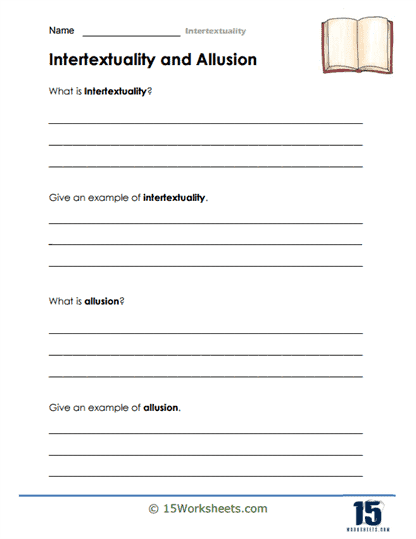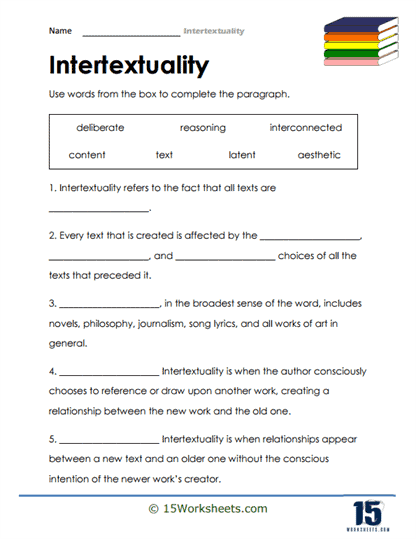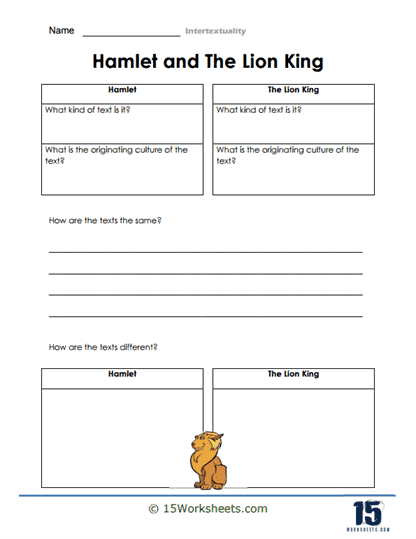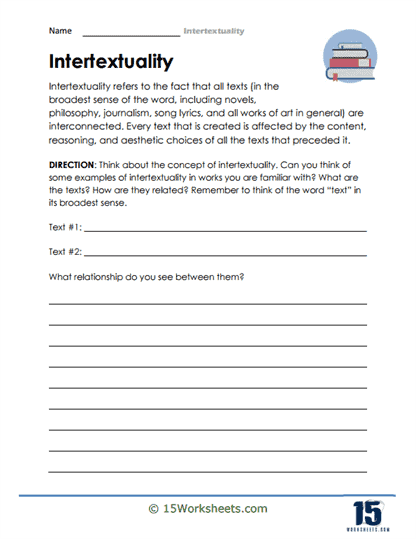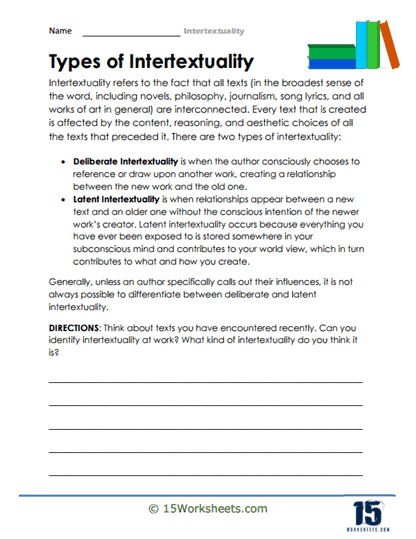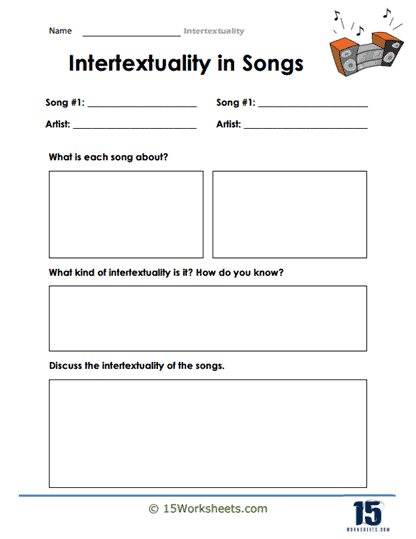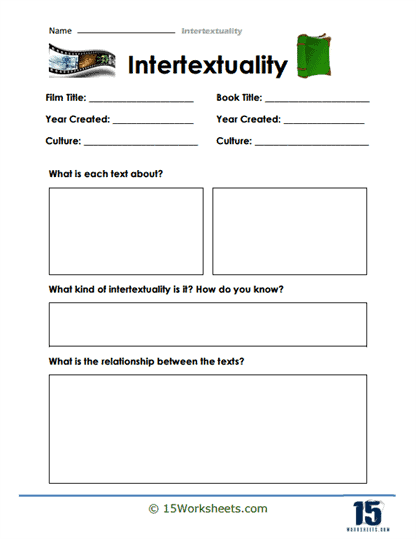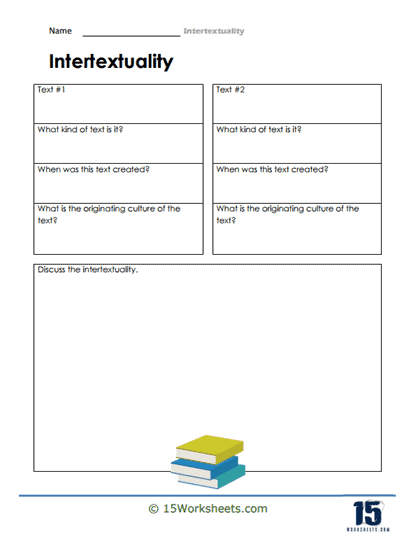Intertextuality Worksheets
About These 15 Worksheets
Intertextuality worksheets are educational resources designed to explore and analyze the concept of intertextuality, which is the relationship between texts and how they reference, influence, or echo each other. This concept, first introduced by Julia Kristeva in the 1960s, highlights the interconnectedness of literary works and other media, suggesting that a text is not an isolated work but part of a network of texts influenced by and influencing one another. Intertextuality can manifest through direct quotation, allusion, adaptation, parody, and a wide range of other references. These worksheets aim to develop students’ abilities to recognize and interpret intertextual connections, enhancing their analytical, comparative, and critical thinking skills in language arts.
By engaging with these worksheets, students not only enhance their analytical and critical thinking skills but also develop a richer, more nuanced appreciation for literature and its role within the broader tapestry of human culture and communication. Through the exploration of intertextuality, students learn to see texts not as isolated works but as part of an ongoing dialogue that spans history and media, deepening their engagement with the world of literature and beyond.
Types of Exercises
Identification – Students are given passages or examples from various texts and asked to identify intertextual references. This could include direct quotes from other works, allusions to historical events, adaptations of character archetypes, or thematic parallels. These exercises help students develop the skill of recognizing intertextual connections.
Analysis – After identifying intertextual references, students analyze their significance within the text. This involves exploring how the reference contributes to themes, character development, or narrative structure. Analysis exercises encourage students to think critically about the function of intertextuality in adding layers of meaning to a text.
Comparisons – These exercises involve comparing two or more texts that share intertextual connections. Students evaluate how one text reinterprets, challenges, or expands upon the ideas or themes of another. Comparison exercises enhance students’ understanding of the dialogue between texts across time and genre.
Creative Writing – Students are tasked with creating their own pieces of writing that incorporate intertextual references. This could involve writing a story that alludes to classic literature, composing a poem that references modern pop culture, or creating a dialogue that echoes a famous historical speech. Creative writing exercises encourage students to apply their understanding of intertextuality in practice, fostering creativity and innovation.
Research Exercises – Students research the historical and cultural context of specific intertextual references to understand their significance more deeply. This might involve exploring the original context of a biblical allusion, the historical background of a literary quotation, or the cultural significance of a mythological reference. Research exercises enhance students’ ability to connect texts with their broader historical and cultural contexts.
Discussion and Debate – Through group discussions or debates, students share their interpretations of intertextual connections and consider different perspectives on their significance. This fosters collaborative learning and helps students articulate and defend their analyses.
Adaptation and Parody Exercises – Students analyze adaptations and parodies, examining how they reinterpret or critique the source material through intertextuality. This can involve comparing a classic work with its modern adaptation or exploring a parody’s commentary on its original text. These exercises help students understand the creative and critical potential of intertextuality.
Multimedia Exercises – Given the prevalence of intertextuality in media beyond literature, such as film, music, and art, these exercises encourage students to identify and analyze intertextual references across different media forms. This fosters an appreciation for the multidimensional nature of texts and the interconnectedness of cultural products.
The Benefits of These Worksheets
Engaging with intertextuality worksheets offers a comprehensive approach to enhancing students’ language arts and reading skills:
Enhanced Textual Analysis Skills – By identifying and analyzing intertextual references, students learn to engage with texts on a deeper level, appreciating the complex web of connections that give literature its richness and depth.
Improved Critical Thinking – Analysis and comparison exercises encourage students to think critically about the relationships between texts, fostering skills in interpretation, evaluation, and synthesis.
Increased Cultural and Historical Knowledge – Research exercises expand students’ knowledge of historical, cultural, and literary contexts, enriching their understanding of texts and the world in which they were created.
Creative Expression – Creative writing exercises that incorporate intertextuality challenge students to think creatively and innovatively, applying their knowledge in original ways.
Collaborative Learning – Discussion and debate exercises promote collaborative learning, encouraging students to share ideas, listen to different perspectives, and refine their arguments.
Media Literacy – Multimedia exercises enhance students’ media literacy, enabling them to navigate the complex landscape of contemporary media and recognize the intertextual nature of cultural products.
Adaptability and Flexibility in Thinking – Engaging with adaptations and parodies helps students appreciate the fluidity of texts and the ways in which meanings can be reshaped and reinterpreted across time and media.
Comprehensive Understanding of Texts – Through intertextuality worksheets, students develop a more holistic understanding of literature as part of a larger cultural and textual network, recognizing the dialogues and debates that shape and are shaped by texts.
What is the Literary Device of Intertextuality?
Intertextuality, a term coined by Julia Kristeva in the 1960s, refers to the complex web of relationships that exist between texts. It is the way in which texts influence, reference, or echo each other, either directly or indirectly. Intertextuality underscores the idea that a text is not an island unto itself but rather a mosaic, pieced together from countless other texts, be they literary works, films, art, or cultural narratives. This interconnectedness suggests that meaning in a text is shaped not only by the author’s intent but also by its relationship to other texts and the broader cultural context.
Main Defining Feature of Intertextuality
The main defining feature of intertextuality is its emphasis on the relational aspect of texts. Unlike traditional notions of authorship and originality that prioritize the singular vision of the author, intertextuality focuses on the dialogues between texts, highlighting how they borrow from, contrast with, and build upon each other. This approach shifts the focus from the creation of texts to their reception and interpretation, acknowledging that readers bring their own textual memories and experiences to bear on any text they encounter.
Characteristics of Intertextuality
Referentiality – Intertextuality involves the reference to or incorporation of one text within another. This can range from explicit quotations to subtle allusions or thematic parallels.
Dialogism – Borrowing from Bakhtin’s concept of dialogism, intertextuality suggests that texts are in constant dialogue with each other, engaging in a kind of textual conversation across time and space.
Layering – Intertextual works often contain multiple layers of meaning, with each intertextual reference adding depth and complexity. This layering effect enriches the reader’s experience by providing a multiplicity of readings and interpretations.
Hybridity – Intertextuality often results in hybrid texts that blend genres, styles, and sources, challenging traditional boundaries and categories in literature and art.
Cultural and Historical Context – Intertextual references are imbued with the cultural and historical contexts of both the referencing and referenced texts, linking individual works to larger cultural narratives and histories.
Examples of Intertextuality in Literature
Example 1 – “The Waste Land” by T.S. Eliot
T.S. Eliot’s “The Waste Land” is a quintessential example of intertextuality in modernist literature. The poem is a mosaic of literary and cultural references, drawing from a wide range of sources including Dante’s “Inferno,” Shakespeare’s plays, the Bible, and ancient myths. These references serve not only to enrich the poem’s imagery and thematic content but also to position it within a broader literary and cultural conversation. Eliot’s extensive use of footnotes to indicate his sources further underscores the poem’s intertextual nature, inviting readers to engage with the text on multiple levels.
Example 2 – “Ulysses” by James Joyce
James Joyce’s “Ulysses” is another landmark work of intertextuality, structured around the framework of Homer’s ancient epic, “The Odyssey.” Joyce parallels the adventures of Odysseus with a day in the life of Leopold Bloom in Dublin, using the structure of the ancient text to explore themes of identity, homecoming, and the nature of heroism in the modern world. This intertextual framework allows Joyce to engage with timeless themes while also critiquing and reinterpreting them for a contemporary audience.
Example 3 – “Wide Sargasso Sea” by Jean Rhys
Jean Rhys’s “Wide Sargasso Sea” serves as a prequel to Charlotte Brontë’s “Jane Eyre,” focusing on the backstory of Bertha Mason, the “madwoman in the attic” from Brontë’s novel. Rhys’s text is an act of literary reclamation that gives voice to a marginalized character, exploring themes of colonialism, race, and gender that were only hinted at in the original text. This intertextual engagement not only deepens our understanding of “Jane Eyre” but also challenges its assumptions, showcasing the power of intertextuality to critique and transform existing narratives.
Effect of Intertextuality on the Reader
Intertextuality enriches the reading experience in several ways:
Enhanced Depth and Complexity – Intertextual references add layers of meaning to a text, encouraging readers to make connections and uncover hidden depths. This can transform the act of reading into an active, engaging process of discovery.
Cultural and Historical Engagement – By linking texts to other works and cultural narratives, intertextuality invites readers to consider the broader historical and cultural contexts that shape literary meaning, enhancing their understanding of both the text in question and the referenced works.
Critical Thinking and Interpretation – Encountering intertextual references prompts readers to think critically about the relationships between texts, fostering skills in analysis, interpretation, and comparative reading.
Dialogic Imagination – Intertextuality cultivates a dialogic imagination, encouraging readers to see texts as part of an ongoing cultural conversation. This can lead to a more nuanced appreciation of literature’s role in reflecting and shaping human thought and society.






